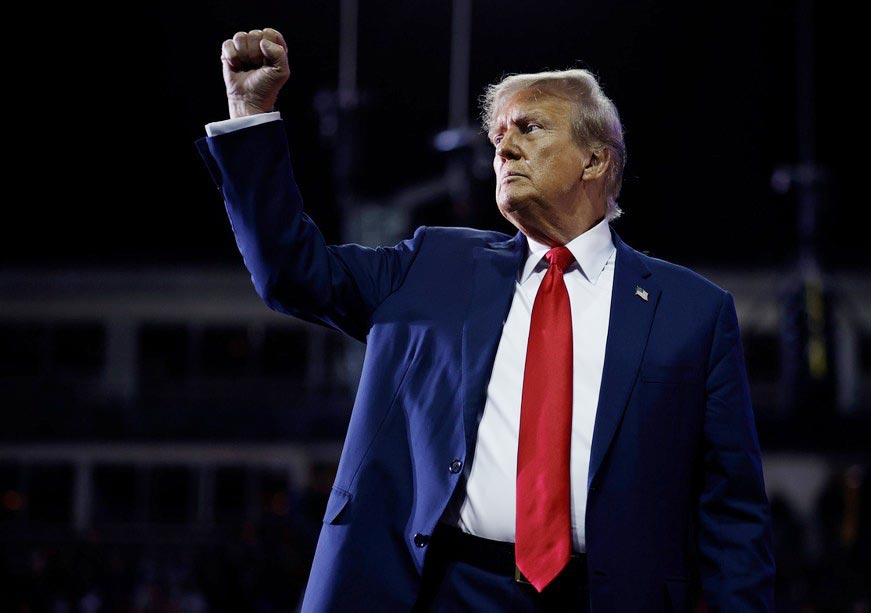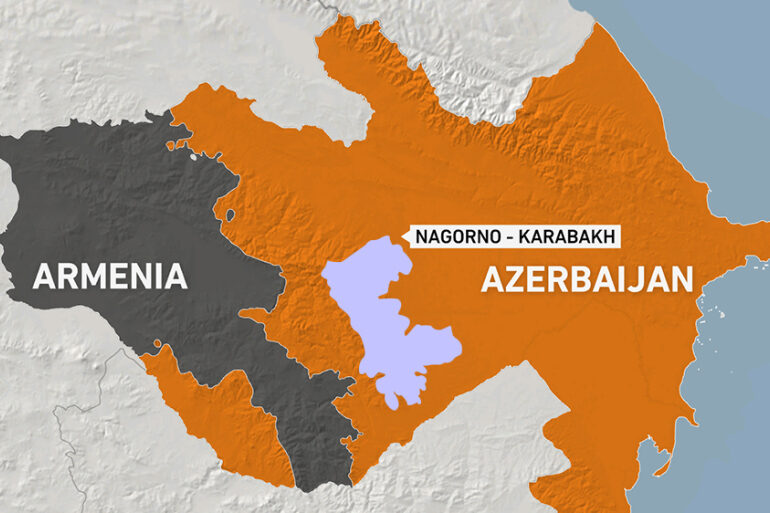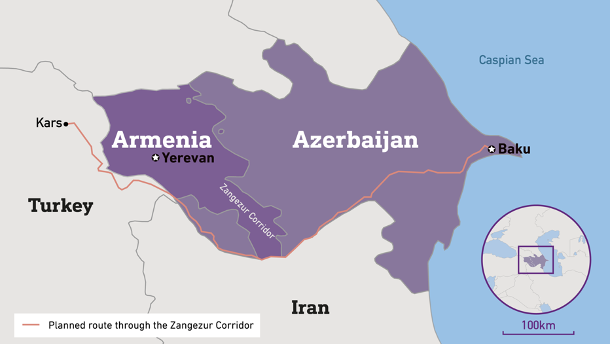-
CENTRES
Progammes & Centres
Location
Despite Trump’s proposed isolationism, Russia’s diminishing influence and China’s rise in the South Caucasus and West Asia might motivate a renewed interest in the region

Image Source: Getty
It is easy to predict that the Trump 2.0 administration will not focus on the South Caucasus owing to a broad consensus that Donald Trump is unlikely to start new geopolitical entanglements on his watch. Given Russia’s continued influence in the region, opening another front in the backyard of Moscow may be a deterrent, especially in times of the extant flux in the global order. However, a closer look at his team and their inclinations may suggest otherwise: Trump’s pick for the Secretary of State, Marco Rubio, has spoken out against Azerbaijani President Ilham Aliyev’s human rights record and authoritarianism. In the past, he also co-sponsored a bill condemning Baku’s blockade of Nagorno-Karabakh.

Map Credits: Indian Defence Review
The highlighted purple territory is the disputed Nagorno-Karabakh, originally a part of Armenia.The Lachin Corridor connects Nagorno-Karabakh to Armenia, but Azerbaijan has blocked this corridor.
Additionally, the outcome of the Russia-Ukraine war and Trump’s big foreign policy promises during his campaign could keep the United States (US) tethered to the Caucasus. More importantly, a new Trump administration would inherit some of the Biden administration’s policy priorities, particularly Biden’s heightened focus on the region during the escalation of the Nagorno-Karabakh conflict in his term. While the isolationist pull for the incoming Trump administration’s policies will be heavy, the geopolitics of the South Caucasus may increasingly be difficult for Washington to ignore, especially with the outsized role of China, Türkiye and Iran in the region.
In January 2024, the remaining portion of Nagorno-Karabakh, despite being ethnically and culturally Armenian, was officially integrated into Azerbaijan. Consequently, thousands of residents fled to Armenia. The Karabakh population have wished to be a part of Armenia since 1923. While Azerbaijan’s plan to establish full control over Nagorno-Karabakh appears complete on paper, several ongoing peace agreements, negotiations, and debates regarding the displaced Karabakh population remain unresolved. Tensions also linger over the proposed “Zangezur Corridor”, which aims to connect Türkiye and mainland Azerbaijan, probing broader regional issues. This dispute has also attracted attention from a host of countries, including both traditional regional players and newer ones such as India, China and Pakistan, all seeking to establish a geopolitical foothold in the Caucasus driven by interests in defence, trade, and strategic power dynamics.
Planned route of the Zangezur Corridor

Map Credits: Middle East Eye
The Zangezur corridor, if established, would geographically isolate Armenia from Iran, a key ally for the country in this dispute. Iran and Armenia are tied by a US$500-million arms deal and share an essential energy partnership: a 140-kilometre oil and gas pipeline that runs from Iran into the southern Armenian border. In exchange for oil and gas, Armenia supplies electricity to Iran. The establishment of the Zangezur, in addition to cutting off Armenia from Iran, would also put Yerevan and Tehran at the disposal of Türkiye and Azerbaijan to maintain this pipeline. Moreover, the two countries will likely face additional challenges as Tehran is set to increase its gas supply to Yerevan. Therefore, in the scenario where Zangezur is established, Iran-Armenia joint establishments risk becoming unsustainable.
Nuanced complexities have, therefore, emerged due to India's growing involvement in the region, particularly through its partnerships with Iran and Armenia, as well as China and Pakistan's engagements, shaped by their alliances with Azerbaijan and Türkiye.
Iran and Armenia have, in partnership, also constructed the controversial Khudafarin dam. This hydropower plant lies in the Azerbaijani district of Jabrayil, located in mainland Armenia. Although unlikely to be impacted by the potential construction of Zangezur, the completion of this project in May 2020 triggered protests against Tehran and Yerevan by the Azeris, challenging the legitimacy of the dam’s ownership by the two nations.
With Russia’s waning influence in the Caucasus and America’s limited involvement in the region, several countries continue efforts to establish a stronghold in the area. Nuanced complexities have, therefore, emerged due to India's growing involvement in the region, particularly through its partnerships with Iran and Armenia, as well as China and Pakistan's engagements, shaped by their alliances with Azerbaijan and Türkiye. Perhaps most importantly, China is emerging as a dominant player in Eastern Europe as well as the Caucasus. World Bank data reveals that between 2005 and 2020, Chinese trade turnover with Armenia, Azerbaijan, and Georgia surged by approximately 2,070 percent, 380 percent, and 1,885 percent, respectively. China also serves as a market for nearly all of Iran’s oil supply. Russia’s ongoing war in Ukraine diminishes its role in the region, increasing China’s economic leverage from West Asia to the Caucasus.
When, in 2020, the Nagorno-Karabakh war escalated to its most aggressive phase yet, despite being a member of the Organization for Security and Co-operation in Europe (OSCE) Minsk Group, the US remained notably silent on the conflict. Former US Ambassador Carey Cavanaugh, who was previously involved in efforts to resolve the Karabakh conflict, stated that the US had not “coordinated” with other Minsk Group members, France and Russia. This lack of engagement highlighted the Trump 1.0 administration’s economic and strategic disinterest in the Caucasus. Trump and Pompeo continued to limit themselves to encouraging a ceasefire, a stance largely mirrored by the Biden administration later.
Since September 2024, geopolitical grounds in the southern Caucasus have shifted considerably. While Russia continues to maintain its influence in the region with a fragmented focus, other players such as Türkiye and China have been able to expand their ground. In response, President Biden has shown some, albeit limited, interest in strengthening strategic ties with Yerevan. Armenian Prime Minister Nikol Pashinyan has publicly indicated plans to distance Armenia from Russia due to Putin’s cooperation with Baku. Over the past few years, Russia has predominantly supported Azerbaijan’s claims to Nagorno-Karabakh. Russia’s backing of Baku and its efforts to overshadow Türkiye's influence in the region signal an opportunity for the US to strengthen its presence in the Caucasus through Armenia, thereby counterbalancing both Russia and Türkiye.
In a “sticks and carrots” scenario, America’s potential investment in Armenia would act as the ‘carrots’, offering incentives that could enable Armenia to promptly dissolve its ties with Russia.
There are various reasons why the incoming Trump administration could be much more interested in Armenia and more likely to form a regional strategy of working with other like-minded partners in the Caucasus. America’s trans-Atlantic partner France has invested in Armenia since 2016 to counter Russia and also Türkiye, with which it shares a historical rivalry, and has been competing for influence in the Mediterranean and Africa. Therefore, the second Trump administration is likely to invoke a financial or trade link to the Caucasus or explore investment opportunities in the region. Trump’s historically tense relationship with Turkey’s Erdogan, combined with Ankara’s active welcome of Chinese investment pertaining to the Belt and Road Initiative (BRI), may further motivate a shift in US policy toward strengthening ties with Armenia. Trump 2.0 administration’s “anti-China” theme is likely to probe America to establish its influence in the region to counter Beijing’s ambitions in the Caucasus, but also in West Asia. Given America’s endangered influence in the Middle East (where China has made recent major strides), it could look at the Caucasus as an essential new regional focus.
In a “sticks and carrots” scenario, America’s potential investment in Armenia would act as the ‘carrots’, offering incentives that could enable Armenia to promptly dissolve its ties with Russia. The ‘sticks’ in this case are the pressures Armenia faces from its isolation, as it is surrounded by supporters of Azerbaijan and Russian allies, many of which are unsupportive of Yerevan. Thus, Armenia, in the recent past, has signalled its proximity to the West and the US. With its neighbour Georgia moving towards a pro-Kremlin policy, strengthening the America-Armenia alliance could be a possibility, especially if Armenia opens up to investments from the US.
It is imperative to highlight that while Russia continues to hold influence in the Caucasus, its position in the region will be tested due to its war with Ukraine. Whether the Trump administration has the appetite for capitalising on Russia’s diminished influence and the growing geopolitical shifts in the region remains to be seen.
Kashvi Chaudhary is a Research Intern at the Observer Research Foundation
Vivek Mishra is Deputy Director with the Strategic Studies Programme at the Observer Research Foundation.
The views expressed above belong to the author(s). ORF research and analyses now available on Telegram! Click here to access our curated content — blogs, longforms and interviews.

Kashvi Chaudhary is a Research Intern at the Observer Research Foundation ...
Read More +
Vivek Mishra is Deputy Director – Strategic Studies Programme at the Observer Research Foundation. His work focuses on US foreign policy, domestic politics in the US, ...
Read More +